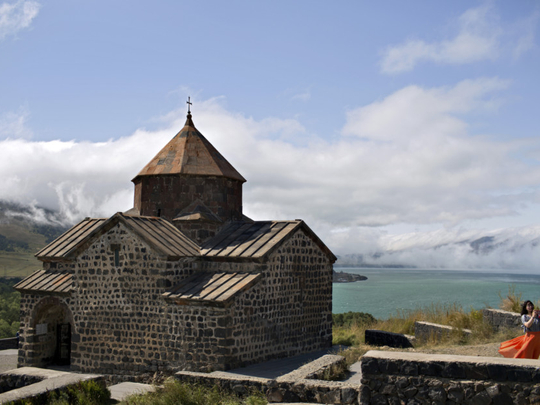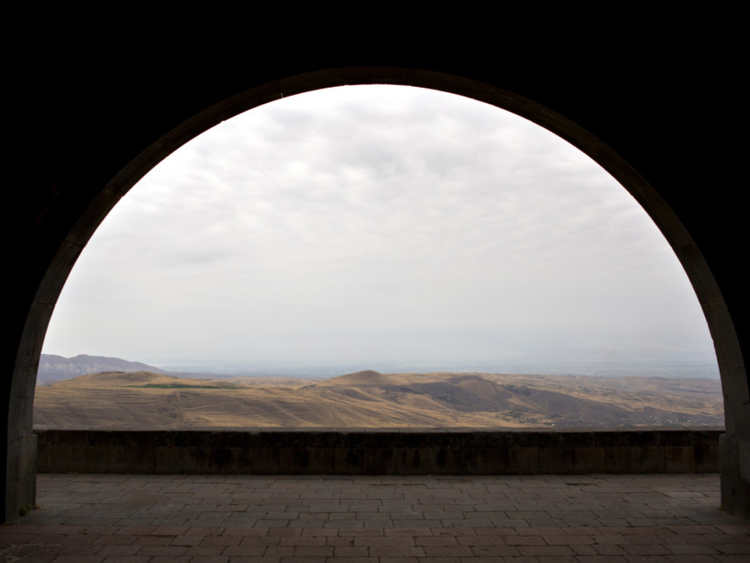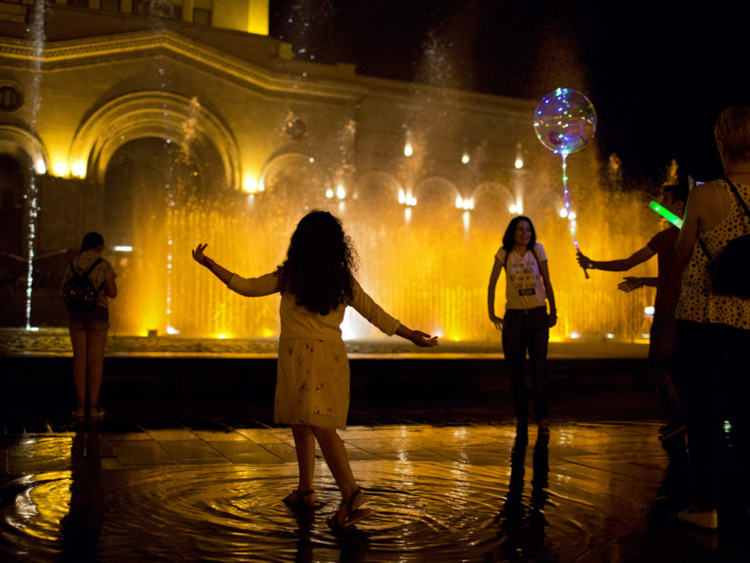
Each time I’ve come to Yerevan in the past decade, the city has surprised me with its evolving elegance and cultural richness. The downtown has an energy that is a long way from the sleepy Soviet city I first visited in the 1980s. Walking the shady avenues off Republic Square on a recent visit, I found the city has become a hip place, with wine bars, microbreweries, cafes, art galleries, boutiques selling crafts and carpets, and an ever-new array of restaurants, as well as upscale hotels and clothing stores.
The new mood is defined by the millennial generation’s role in the velvet revolution of this past spring. After weeks of peaceful protests, the civil society has pushed from power an old regime that much of the nation viewed as dysfunctional and corrupt, representing a continuation of old Soviet mentalities. When Nikol Pashinyan, a prominent journalist, activist and former parliamentarian became prime minister on May 8, a sense of a new era enveloped the country.
In June, I sat in a vine-trellised courtyard restaurant and art gallery on Abovian Street with Armen Ohanyan, a young fiction writer, and Arevik Ashakharoyan, a literary agent. I was hearing Armenia’s new voices of optimism.
Having written about Armenia for decades, their words resonated. I am a poet and nonfiction writer of Armenian ancestry and have been to Armenia five times in the past decade. My trips are often connected to my work — a translation of one of my books, a lecture tour, a symposium.
EXPLORING THE PAST
I started the day grazing on a classic Armenian breakfast spread at the Armenia Marriott Hotel Yerevan, an elegant hotel on Republic Square with fine local cuisine: bastermas (spicy, cured beef); paper-thin or thicker warm lavash; local cheeses; jams with strawberries or apricots or walnuts; thick yogurt; cherries, apricots, blackberries and melons from local orchards; fruit nectars and orange, red and brown rolls of thick grape molasses stuffed with walnuts (sujuk); and black tea from a samovar. The presentation was beautiful, and the Caucasian sun poured through the windows.
Like its cuisine, the country has a long, rich history. Armenia, which became an independent republic in 1991 after the fall of the Soviet Union, is a small, landlocked nation in the southwest Caucasus, at the crossroads of Europe and Asia. The country today is what remains of a once-ancient empire that stretched from the Mediterranean to the Caspian Sea in the first century BC, before it was conquered by the Romans. It was the first nation to make Christianity its state religion, in 301.
Conquered by Byzantines, Persians, Mongols and Seljuks, then colonised by the Ottoman Turks in the 16th century, Armenians were subject to large-scale massacres in the 19th century, during the reign of Sultan Abdul Hamid II, and were the victims of what genocide scholars regard as one of the first genocides of the modern era, by the Ottoman Turkish government in 1915. (Turkey denies that the killings were genocide.)
Armenia became a Soviet Republic in 1920, endured Stalin’s purges and repression, a massive earthquake in 1988 and a war with neighbouring Azerbaijan in the 1990s that has flared up again in recent years over the province of Nagorno-Karabakh. By all rational odds, Armenia should not be on the map today.
Having survived such a harsh history, Armenia has emerged as a democracy that cherishes the many layers of its past. Today, the capital, Yerevan — which dates to the seventh century BC and was founded on the walls of the Urartian city of Erebuni — is a blend of ancient culture, artisan tradition, modern architecture and high-tech, postmodern style, exemplified by the new condominiums and high-end shops on the pedestrian Northern Boulevard.
On September 29-30, Yerevan will celebrate its 2,800th anniversary, making it one of the oldest cities in the world. In the ruins of the ancient fortress on Erebuni Fortress Hill, fragments of murals with images of sacred animals evoke the late Bronze Age. The Erebuni museum has a fine collection of artefacts, including a huge wine storage container that documents Armenia’s winemaking tradition from the Bronze Age.
RICH HERITAGE
Yerevan is a city where many avenues are named after Armenia’s great figures: the early 20th-century poet Yeghishe Charents, the fifth-century historian Movses Koranatsi, the 19th-century novelist Katchadour Abovian, the composer Komitas (1869-1935), to name a few. It’s a city of great museums, including the Matenadaran, which has a rich collection of medieval illuminated manuscripts and books in Armenian, the National Gallery and the History Museum of Armenia.
I always head first for the intimate museums dedicated to major figures. The Saryan museum, for example, has two floors of works by the avant-garde landscape and modernist painter Martiros Saryan (1880-1972). In a stately stone house, the Sergei Parajanov Museum is a celebration of the great 20th-century filmmaker and visual artist’s work: mixed media collages, paintings, conceptual installations and miniature drawings on matchbooks and bottle caps from the time he was imprisoned by the Soviet authorities for “decadent” art.
I always get a good workout climbing the 572 steps of the Cafesjian Center for the Arts (also known as Cascade). It’s a dramatic complex rising up from the tree-shaded, cafe-abundant Tumayan Street in five monumental limestone tiers of fountains, topiary gardens and sculptures. If you tire of the climb, you can slip inside and take the escalator, and soak up one of the most important collections of modern glass in the world, as well as paintings, drawings and sculpture.
No one should come to Yerevan without visiting the extraordinary Armenian Genocide Museum and Memorial, also known as the Tsitsernakaberd (meaning swallow’s fortress) Memorial Complex. It is situated on a hill that overlooks the city and Mount Ararat, Armenia’s national symbol, just across the border in Turkey.
Built of sleek gray basalt, its elegant new wing was designed by the museum’s director, Hayk Demoyan, and his wife, designer Lucine Matevosian. The wide circular exhibit halls wind from a top floor down to a second floor. Photos, maps and documentary footage on various screens accompany text that explores the history of the horrific events that took the lives of more than 1 million Armenians in 1915. From the museum visitors walk the stone walkway to the memorial — towering twin obelisks (a symbol of eternity) and 12 6-metre high stone pillars — to lean over a large circular area where an eternal flame burns and sacred music plays.
Back in Yerevan for the evening, I dined with friends and found the cuisine more inventive than ever. Restaurants blend the traditions of the Armenian Caucasus with the Middle East as refugees from Syria and Iraq make their impact. At Sherep, one of the hottest new places, with a chic open kitchen and late-night jazz, I had mountain sorrel soup; tender stuffed grape leaves; eggplant sauteed in olive oil and rolled up with minced walnuts, dill, garlic and yogurt; and succulent lamb chops. At Vostan, in an old Russian-period stone building on Abovian Street, I feasted on pink, succulent, wood-grilled Lake Sevan trout.
My travels frequently take me beyond Yerevan. Wherever you go in Armenia, you are journeying through an open-air museum where churches and monasteries, even a Hellenic temple, are built into the cliffs or perched at the edges of canyons or green gorges, with searing vistas framed by the ever-blue sky. Thousand-year-old lacelike carved stone crosses (khatchgars) emerge from fields of roadside poppies.
Because Armenia is defined by mountains, canyons, gorges, forests, rushing streams and rivers, lakes, grassy highlands and dales, it has become a prime destination for hikers. The new Transcaucasian Trail runs from Georgia through Armenia into Azerbaijan, and offers extraordinary trails from the Dilijan National Park in the northern mountains to the caves of Goris in the south. Many trails intersect with ancient monasteries and churches.
For a small country Armenia has an amazing diversity of flora and fauna; about 240 bird species breed in Armenia and nearly 400 move through the country, making Armenia a birder’s paradise.
FERTILE VALLEYS
On a sunny morning, I headed east from Yerevan in a minivan with my superb guide, Katar Taslakyan, and a driver, Raphael Hovakimyan, whose musical selections — jazz and R’n’B — filled the van. About 40 minutes later, we stopped at Charents Arch, an impressive monument to Armenia’s great modern poet Yeghishe Charents (1897-1937). From there, we got a stunning view of the glistening, grassy highlands and snow-capped Mount Ararat.
In another 15 minutes, we were at Garni, a beautifully proportioned Greco-Roman temple believed to have been built by King Tiridates I to the sun deity Mihr. The vistas from Garni, which is perched at the lip of a gorge, are spectacular.
The next day, we drove south from Yerevan into the fertile Ararat Valley. In June, the apricot orchards are popping with Armenia’s bright yellow national fruit and the vineyards are green. On this clear morning, Mount Ararat rose from a bank of clouds and the hot sun was mitigated by cool breezes.
Farther south, in Vayots Dzor province, our van climbed the road to Noravank, a complex that includes two medieval churches, one of which was designed by the architect and artist Momik. Again, I’m blown away as monks’ caves appear in jagged red cliffs that remind me of Arizona, and the milky tan limestone of the Myrig Adzvadzeen church glistens in the sunlight against a brilliant blue sky and rising mountains. The chapel at Noravank is luminous with light pouring through the windows. Gazing out those windows to green hillsides, red cliffs, blue sky, I felt the shimmer of the sublime.
After a night on the Goris River at Mirhav, a beautifully appointed inn with antique Armenian artifacts and rugs, we drove to 3,352 metres through a fantasia of chirping nightingales, swooping eagles and clouds lifting off the green valley to the world’s longest nonstop, reversible tramway to reach Tatev, a ninth-century monastery. As a Baroque concerto spilled through the tramway’s speakers, our glass car floated above villages and ancient churches, by cliffs and grassy mountains and past gliding hawks toward the monastery, with its two conical domed churches perched at the cliff’s edge.
Heading north past potato fields and farmlands, meadows of poppies and royal blue delphiniums, we drove up the western shore of Lake Sevan, one of the largest high-altitude lakes in Eurasia. Its turquoise water is a resort for bathers and fishermen, and an important source for fishing, irrigation and hydroelectric power. At a lakeside restaurant called Dzovadzots, I had a perfect whitefish soup.
A half-hour north, the ninth-century Sevanavank monastery, with its two small beautiful, earth-coloured churches on a peninsula, is worth the climb up the steps from the shore below.
Just north of Lake Sevan, we crossed into the alpine mountain region of Tavush where streams and hiking trails wind through the lush forests of Dilijan National Park. The stunning monastery of Haghartsin is nestled on a forested mountain.
Back in Yerevan the next evening, I walked through an arch onto an old cobblestone street off bustling Amirian Street and found Anteb, a Syrian-Armenian restaurant, where we had spicy, crepe-thin lahmajuns (Armenian pizza); a piquant muhamara (walnut, pomegranate molasses and red pepper dip) that you scoop up with hot, puffy lavash; and kuftas, crisp shells of cracked wheat bursting with lamb and herbs.
I never leave Yerevan without meandering through the Vernissage, the open-air market in a park along Aram and Buzant streets where there are stalls and stalls of ceramics, folk and contemporary art, rugs, textiles, jewellery and more. I bought two small antique Caucasian kilims before I wandered back to Republic Square, where I end most evenings.
At night the square, with its monumental rosy tufa stone buildings, is lit up; the fountains spew through coloured lights, music plays, people dance. It’s a nightly ritual in Yerevan in the warm-weather months — a down-home celebration to end a day, and a resilient response to the harsh history of this new nation that has emerged from an ancient civilisation.













